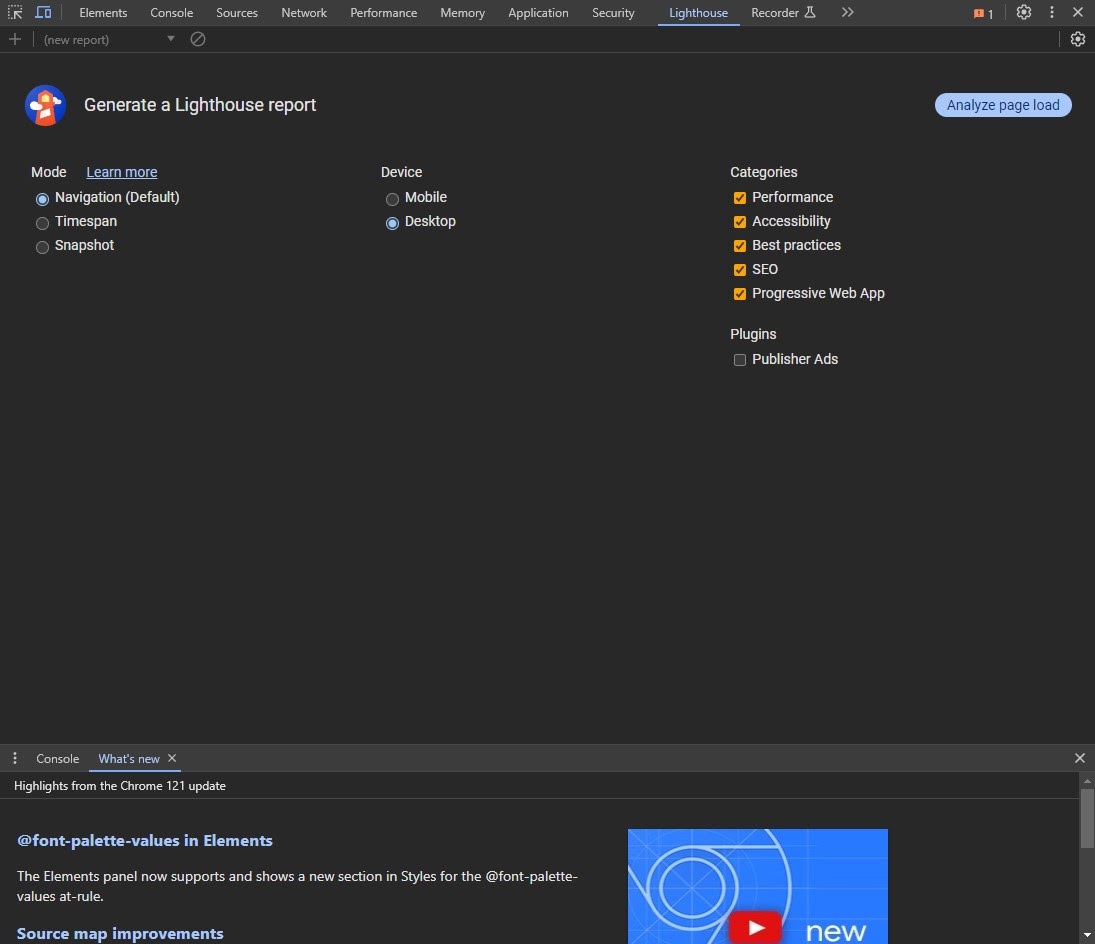44 SEO Tips to Boost Your Website: A Beginner's Guide
Navigating the dynamic world of search engine optimization can be overwhelming for beginners, but fear not! This article is your compass, charting a course through 44 actionable and finely detailed SEO tips that promise to elevate your website's performance.
Explore this beginner-friendly guide as we dive into the core principles and techniques that form the backbone of successful SEO strategies.
1. Build a Well-Designed Website
Crafting a well-designed website goes beyond aesthetics; it's foundational to your SEO strategy. A meticulously structured site not only ensures efficient crawling and indexing by search engines, but also enhances the user experience.

Begin with a responsive and mobile-friendly design, ensuring seamless user experiences across different devices. I like to test my websites using the Device Toolbar inside Google Chrome's Developer Tools.
To access this feature, click F12 on your keyboard to open up the Developer Tools, and then select “Toggle Device Toolbar”.

Make sure to check your website templates for clean and crawlable code, thus minimizing unnecessary elements that might impede search engine bots. Focus on intuitive navigation, organizing content hierarchically with descriptive URLs. A well-designed website not only enhances user satisfaction but also contributes significantly to improved SEO through enhanced crawlability and user engagement.
Tip: If you aim for a larger site, generate a sitemap to aid spiders in navigation for optimal results.
2. Focus on a Specific Topic
Specificity is the heart of SEO success. KOMarketing defines specificity in SEO as a process where the content on the page matches specific keywords, increasing the likelihood of ranking well for those keyword searches. This concept is crucial in SEO as search engines typically favour sites that provide comprehensive, in-depth information on a specific topic.
Concentrate on a defined topic to establish authority and relevance, while steering clear of blending unrelated content on the same site. Delve deeper into your chosen topic, creating comprehensive, in-depth content that answers user queries and provides valuable insights.

Setting specific SEO goals is essential as it provides a target to aim at, allowing you to ensure that your SEO efforts are in service of the goal. These goals should be Specific, Measurable, Achievable, Relevant, and Time-bound (SMART), which aids in crafting an effective SEO strategy.
The structure of your keyword phrases in titles and general writing should be as relevant as possible for your audience, whether that means using short or long keyword phrases. This specificity can improve your site’s visibility in search results, driving more traffic to your site.
Utilize targeted keywords strategically within your content, meta tags, and headers to enhance visibility. Regularly update and expand your content to stay current and signal to search engines that your site is a reliable source, boosting rankings. Developing a content strategy centred around a core theme reinforces the thematic coherence crucial for effective SEO.
Remember, the more specific your content, the better your chances of achieving SEO success.
3. Pick Relevant Keywords
Keyword selection is indeed the cornerstone of SEO. It’s not just about incorporating them into your content, but also about strategically placing keywords in URLs, header tags, meta descriptions, and alt attributes for images. This careful integration optimizes content for search engines, maximizing the potential for ranking on targeted terms.
To enhance keyword relevance, conduct thorough keyword optimisation research using a variety of SEO tools to identify high-impact terms related to your content. Align your chosen keywords with user intent, ensuring they naturally fit within the context of your content. User intent, or search intent, is what users want to achieve when they conduct a specific search. By aligning your content with the intent behind your chosen keywords, you increase your chances of ranking for those keywords.
Stay adaptable in the dynamic SEO landscape by regularly updating and refining your keyword strategy based on changing trends and user behavior. The dynamic nature of SEO necessitates an adaptable keyword strategy.
4. Create Quality Content on a Consistent Basis
Beyond originality, emphasize information-rich and value-providing articles and regular updates. A consistent flow of valuable information, coupled with a well-planned content calendar, signals to search engine algorithms that your site is both active and relevant.
Prioritize content depth and value, offering insights that surpass competitors on the keyword SERPs you want to rank for. Develop a content calendar to maintain a steady publishing schedule, fostering user engagement and signaling reliability to search engines.
Incorporate multimedia elements, such as images and videos, to enhance user experience. Regularly assess and update existing content to reflect industry developments, keeping your site authoritative and current.
- Keyword Research: Start with thorough keyword research. Identify relevant keywords and long-tail phrases that align with your content. Tools like SEMrush or Google Keyword Planner can assist in finding valuable keywords.
- Content Depth and Value:
- Long-Form Articles: Studies show that longer content tends to rank higher. Aim for articles with 1,500 words or more to provide comprehensive information.
- Originality: Unique content stands out. Conduct original research, share case studies, or present fresh perspectives.
- User Intent: Understand user intent behind search queries. Address their needs and questions in your content.
- User Engagement Metrics:
- Dwell Time: Google considers how long users spend on your page. Engage readers with well-structured content, subheadings, and bullet points.
- Bounce Rate: Lower bounce rates indicate better content quality. Optimize readability and provide clear calls-to-action.
- Multimedia Elements:
- Images: Visual content enhances user experience. Use high-quality images related to your topic.
- Videos: Embed relevant videos or create your own. Videos improve engagement and dwell time.
- Content Calendar and Consistency:
- Frequency: Regularly publish content. A consistent schedule signals reliability to search engines.
- Evergreen Content: Mix timely articles with evergreen pieces that remain relevant over time.
- Update Existing Content:
- Historical Optimization: Revise old articles to keep them current. Add new information, update statistics, and refresh the content.
- Broken Links: Regularly check for broken links and fix them. Broken links negatively impact user experience and SEO.
- Metrics and Analytics:
- CTR (Click-Through Rate): Monitor CTR in Google Search Console. Optimize meta titles and descriptions to improve organic clicks.
- Conversion Rate: Measure how well your content converts visitors into leads or customers.
- Backlinks: High-quality backlinks enhance authority. Create link-worthy content to attract natural links.
Remember, quality content isn't just about quantity—it’s about providing value, solving problems, and meeting your readers’ needs. By incorporating these strategies and staying informed about industry trends, you'll create content that resonates with both users and search engines.
5. Create Attractive Page Titles and Headlines
You want to 'sell' the content you've spent hours working on, right?
Creating attractive page titles and headlines is crucial for SEO. A compelling title can increase both click-through rates and visibility on search engines. Experiment with different approaches to strike the right balance, ensuring SEO friendliness for search engines and engaging content for your readers.
Optimize page titles with relevant keywords while maintaining readability. Try to create attention-grabbing headlines that entice users to click while encapsulating the essence of your content. Don't forget to A/B test various title and headline formats to gauge effectiveness and refine your approach. Prioritize clarity and conciseness, allowing both search engines and users to quickly understand the content's relevance and value.
Tip: Include your primary keyword in the title to help search engines understand the content. Make it engaging by invoking curiosity or using power words to attract more clicks. Keep it within 60 characters as longer titles may be cut off in search results.
6. Reduce Your Website's Load Time
Website speed is a critical SEO factor. Utilize tools like Google PageSpeed Insights and consider removing unnecessary plugins, especially for WordPress users. Page load times significantly impact user experience, bounce rates, and search engine rankings.
Tip: I love to use the Lighthouse report that is perfectly integrated in Google Chrome’s developer tools.
- Visit the page you want to optimise in incognito mode.
- Hit F12 on your keyboard.
- On the top bar, click the Lighthouse button. Resize the pane if necessary.

- Click the 'Analyze Page Load' button and let the tool run a page audit.

This audit provides separate scores for Performance, Accessibility, Best Practices, and SEO — plus actionable optimization insights.
7. Optimize Your Images
This one ties in with the previous point, as it helps optimize your website’s load time. Image optimization extends beyond resizing and formatting — it is crucial for SEO. Employ compression techniques, use appropriate file formats, and add Alt attributes. Fast-loading pages enhance user experience and align with search engine algorithms favoring speed.
Tip: Use WebP formats and, if impossible, reduce your image sizes. There are multiple online image compressors out there, but my personal favorite is Squoosh. Note that reducing your image sizes will also downgrade quality — find a balance that maintains user experience without harming page speed.

Credits to ImageRecycle.
8. Write Information-Packed Meta Descriptions
Crafting meta descriptions involves more than summarizing content — it's about enticing clicks without resorting to keyword stuffing. Concise yet informative meta descriptions contribute to higher click-through rates.
Imagine your meta description as your website’s elevator pitch, squeezed into a concise 160-character message that grabs attention, conveys value, and entices clicks. But forget keyword stuffing — the magic lies in understanding your audience.
Put yourself in your reader’s shoes using tools like Google Keyword Planner or AnswerThePublic to unearth their core needs, burning questions, and problems that need solutions. Don’t just list features; highlight the benefits they'll reap, as Econsultancy advises.
9. Address Your URLs
URL optimization is often overlooked but crucial for SEO. Replace dynamic URLs with static ones, incorporate relevant keywords, and use hyphens to separate words. A search-engine-friendly URL structure enhances overall site visibility.

10. Master Internal Linking
Internal linking is not just about user navigation — it's a strategic SEO practice. Natural and sparing internal linking establishes hierarchy and relationships between pages. Anchor text becomes a critical element, signalling the relevance and context of the linked content.
11. Spend Time on SERPs
Understanding search intent demands a deep dive into SERPs. Analyzing features, content types, and the ranking landscape provides valuable insights. Observing the dynamics of Search Engine Results Pages informs strategic decisions, helping your content align with user expectations. I find Ahrefs’ SERP checker incredibly useful.

12. Master the SERP Overlap Test
Assess the similarity of SERPs across different queries to determine if multiple keywords can be targeted with a single piece of content.
13. Aim for Featured Snippets
Use tools like Ahrefs' Site Explorer to uncover snippet opportunities and optimize for "position zero".
14. Boost Your On-Page SEO
Deeply optimize titles, headers, meta descriptions, content, and alt text to align with target keywords.
15. Target Diverse yet Relevant Keywords
Balance high-volume and long-tail keywords to cover multiple customer journey stages.
16. Prune Content After Long Growth
Remove or consolidate low-performing content using audits and smart redirections.
17. Consolidate Website Pages
Use redirects and canonical tags strategically to avoid duplication and strengthen thematic coherence.
18. Implement Historical Optimization
Refresh and optimize older content based on performance data to reclaim organic traffic.
19. Train Visitors to Search for Your Brand
Encourage branded searches through strategic content and engagement.
20. Develop Page Authority
Earn backlinks via guest posts, networking, and high-quality content (E-A-T principles).
21. Leverage the Pillar-Cluster Model
Use HubSpot's model to structure content around interlinked topic clusters.
22. Create a Link-Building Strategy
Target high-authority sites, conduct outreach, and build authoritative backlinks.
23. Don't Change URLs
Maintain URL stability to preserve SEO value and avoid disruptions.
24. Compress and Optimize Multimedia Files
Balance quality and load time using WebP and CDNs for efficient multimedia delivery.
25. Use Image Alt Text
Describe images accurately with alt text to aid search engines and accessibility.
26. Leverage CTAs
Place calls-to-action effectively using A/B testing and performance tracking.
27. Form Good Relationships with Developers and Designers
Collaborate closely for technically sound and SEO-friendly implementation.
28. Conduct a Technical SEO Audit
Regularly monitor page speed, sitemaps, URL structure, and site architecture.
29. Check, Double-Check, and Triple-Check Your Data
Use multiple sources and scripts to ensure the accuracy of SEO data.
30. Use Keywords in the Right Places
Prioritize placement in titles, URLs, and early content for maximum impact.
31. Keep Users On Your Site Longer
Use behavioral analytics and structured content to boost engagement metrics.
32. Find "Suggest" Keywords
Leverage Google Suggest and similar tools to uncover semantic search opportunities.
33. Delete Zombie Pages
Audit and remove or redirect thin or outdated pages.
34. Do an Industry Study
Use scraping tools and APIs for research that positions your site as an authority.
35. Add Related Keywords to Your Content
Use NLP-based tools to enrich content semantically.
36. Add Text to Infographics, Podcasts, and Videos
Enhance multimedia with transcripts and schema for better indexing.
37. Update Old Pages
Regularly refresh content using audit tools and version control.
38. Speed Up Your Website
Use CDNs and server-side optimizations to reduce load times.
39. Use Google Search Console
Actively monitor, interpret, and act on GSC insights.
40. Create Content Around Shoulder Niches
Use ML tools to expand into related topic areas strategically.
41. Get Backlinks From Your Visual Assets
Encourage visual asset backlinks via reverse image searches and outreach.
42. Create Branded Keywords
Promote unique brand terms supported by schema and redirect strategy.
43. Add "What Is X" Definitions to Blog Content
Integrate clear definitions with NLP and strategic placement for voice/search optimization.
44. Rank in Featured Snippets
Structure content with headers and schema, and test formats to win position zero.
Conclusion
Embarking on the SEO journey requires a harmonious blend of technical acumen and strategic prowess. Each of the 44 actionable tips unveiled here serves as a catalyst, propelling novices and seasoned professionals alike into the realm of SEO sophistication. It's not merely about crafting well-designed websites or strategically placing keywords; it's about mastering the delicate balance between user experience and search engine algorithms.
Stay vigilant in monitoring emerging trends, adapt proactively to algorithmic shifts, and consistently refine your technical prowess. In the relentless pursuit of SEO excellence, your commitment to navigating the complexities of this dynamic field with unwavering finesse will not only yield tangible results but also establish you as a beacon in the vast sea of online visibility.
As the SEO journey unfolds, let these tips be your guiding stars, leading you towards sustained success and prominence in the competitive digital sphere.

